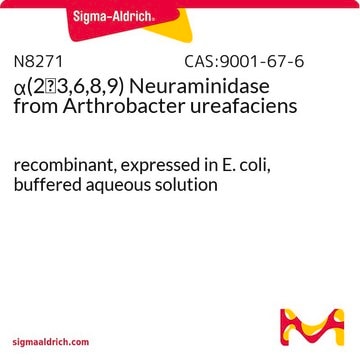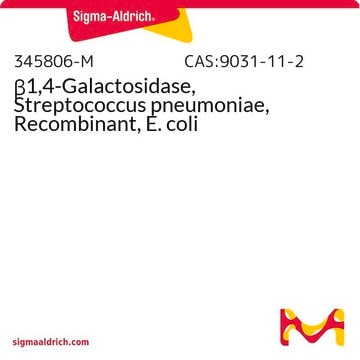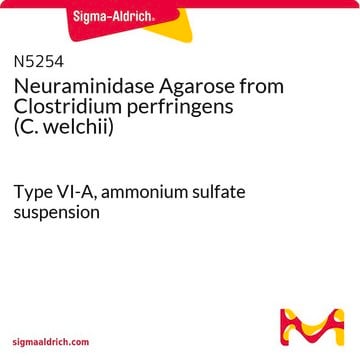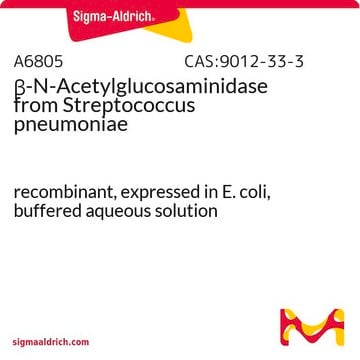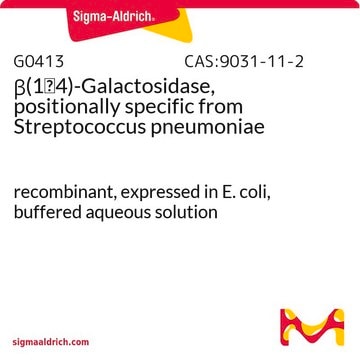It is shipped at ambient temperature, but it is to be stored at 2-8 °C for long term storage. Do not FREEZE as it is in a buffered aqueous solution.
N7271
α(2→3) Neuraminidase from Streptococcus pneumoniae
buffered aqueous solution
Synonyme(s) :
Acyl-neuraminyl Hydrolase, Acylneuraminyl hydrolase, Receptor-destroying enzyme, Sialidase
Sélectionner une taille de conditionnement
1 210.00 CHF
Date d'expédition estimée le26 mai 2025
Sélectionner une taille de conditionnement
About This Item
1 210.00 CHF
Date d'expédition estimée le26 mai 2025
Produits recommandés
Source biologique
Streptococcus pneumoniae
Niveau de qualité
Forme
buffered aqueous solution
Concentration
≥5 units/mL
Activité étrangère
β-Galactosidase, α-mannosidase, β-hexosaminidase, α-fucosidase, and proteases, none detected
Conditions d'expédition
wet ice
Température de stockage
2-8°C
Informations sur le gène
Streptococcus pneumoniae R6 ... nanB(933504)
Catégories apparentées
Actions biochimiques/physiologiques
Conditionnement
Définition de l'unité
Forme physique
Notes préparatoires
Mention d'avertissement
Danger
Mentions de danger
Conseils de prudence
Classification des risques
Resp. Sens. 1
Code de la classe de stockage
13 - Non Combustible Solids
Classe de danger pour l'eau (WGK)
WGK 1
Point d'éclair (°F)
Not applicable
Point d'éclair (°C)
Not applicable
Équipement de protection individuelle
Eyeshields, Gloves, type N95 (US)
Faites votre choix parmi les versions les plus récentes :
Déjà en possession de ce produit ?
Retrouvez la documentation relative aux produits que vous avez récemment achetés dans la Bibliothèque de documents.
Les clients ont également consulté
Articles
Understand sialic acid structure, function, signaling, and modifications. Easily find products for sialic acid research.
-
What is the long term storage and shipping condition of ?(2—›3) Neuraminidase, Product No. N7271?
1 answer-
Helpful?
-
-
What is the molecular weight of ?(2—›3) Neuraminidase, Product No. N7271?
1 answer-
The molecular weight of this ?(2—›3 Neuraminidase enzyme is approximately 75 kDa.
Helpful?
-
-
What is the Department of Transportation shipping information for this product?
1 answer-
Transportation information can be found in Section 14 of the product's (M)SDS.To access the shipping information for this material, use the link on the product detail page for the product.
Helpful?
-
-
For ?(2—›3) Neuraminidase, Product No. N7271, what is the optimum pH range for the neuraminidase enzyme activity?
1 answer-
The optimum pH range for ?(2—›3 neuraminidase is 6.0. Please see the data sheet.
Helpful?
-
-
What are the reaction conditions of the enzyme ?(2—›3) Neuraminidase, Product No. N7271?
1 answer-
One nanomole of substrate or less can be cleaved in a 20 μL reaction volume. In the standard reaction use: 4 μL of 5X enzyme reaction "buffer B" (=250 mM sodium phosphate buffer, pH 6.0), a combined volume of 14 μL containing purified oligosaccharide and water and 2 μL of NANase I (N7271). Incubate 1 hour at 37 °C. To cleave more than one nanomole of substrate, increase reaction volume and enzyme proportionally.
Helpful?
-
Active Filters
Notre équipe de scientifiques dispose d'une expérience dans tous les secteurs de la recherche, notamment en sciences de la vie, science des matériaux, synthèse chimique, chromatographie, analyse et dans de nombreux autres domaines..
Contacter notre Service technique


